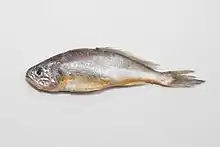Larimichthys polyactis
Larimichthys polyactis, called the redlip croaker, small yellow croaker, little yellow croaker or yellow corvina,[1] is a species of croaker native to the western Pacific, generally in temperate waters such as the East China Sea and the Yellow Sea.
| Small yellow croaker | |
|---|---|
 | |
| Scientific classification | |
| Kingdom: | Animalia |
| Phylum: | Chordata |
| Class: | Actinopterygii |
| Order: | Acanthuriformes |
| Family: | Sciaenidae |
| Genus: | Larimichthys |
| Species: | L. polyactis |
| Binomial name | |
| Larimichthys polyactis (Bleeker, 1877) | |
| Synonyms | |
|
Pseudosciaena polyactis Bleeker, 1877 | |
Diet
They are benthopelagic feeders that usually eat shrimp, zooplankton, or sometimes small fishes.
Habitat
They remain in shallow waters above 120 m, but avoid brackish conditions. They are typically found where the sea floor is sand or mud.
Morphology
Males can reach 42 cm while the common height is about 30 cm. Their body shape is almost rectangular. They have red lips, grey gold body, gold belly and light yellow fins. The inside of its mouth is white and the gill slit is black. In its head are two hard, pale, white bones that keep balance when they swim, which is also used as a material for medicine. They can make noise by moving their air bladder in order not to scatter.
Behavior
They have a habit of leaping above the sea. In winter, they move to warm water. The breeding season is from March to June. Usually they spawn 30,000 ~ 70,000 eggs.
Relation to humans
Once an abundant commercial fish off China, Korea and Japan, its population collapsed in the 1970s due to overfishing.[2] Global catch later rebounded, with 388,018 t landed in 2008.[3] Salted and dried, they are a food product known as gulbi (굴비) in Korean. Yeonggwang gulbi is a prized delicacy, selling for over $100 a bunch.
Culture
During the reign of Yejong, who was the 16th king of the Goryeo dynasty, Lee Ja-kyum made his daughter, Sundeok, become Queen and let her child, and therefore his grandson, Injong, be enthroned.
Lee Ja-kyum was thirsty for power and gave his two other daughters as wives to Injong. He became strong through the marriage and rose to prominence. Lee Ja-kyum was later exiled. He first ate Yeonggwang gulbi while in exile. He sent some to the king as a present. Lee Ja-kyum named it gulbi which means "resist", stating that he would not yield. (屈非:It means resist and is pronounced ‘gulbi’ in Korean).
Yeonggwang gulbi was then served on a royal table and became famous.[4]
Yeonggwang dried yellow corvina is the favorite choice in Beobseongpo. While spawning, croakers, migrate to Yeonpyeong Island. They are the plumpest and contain the greatest number of eggs when they pass the coastal waters of the Chilsan Sea. They are caught, seasoned with Yeonggwang Bay salt, and dried with the sea breeze.[5]
Preparation
The basic preparation steps are sorting, salting, weaving, washing, drying and preserving. Each step differs according to the type of gulbi. The order of steps also differs. Traditional and modern preparation also differs. Traditionally, the fish had to be preserved for long period, so drying was preferred. Once technology of keeping food refrigerated developed, gulbi does not have to be dried. Less salt is used.[6]
Barley extraction
The Gulbi is usually prepared from November to March. 7.27℃~-3℃ is adequate for preparation. Yellow croakers are sorted by size and weight. Salt can be directly dropped, or the croakers can be washed in salt ponds. After 8 hours, they are woven in groups of 10 or 20 units. Then they are washed in clean water. Lastly, woven croakers are dried with barley for 3~6 hours.
Ocher
A germicide is made of ocher, salt, organic acid and ethanol. Then the fishes are put in a salt pond. If they are large enough, they are kept in the salt pond for more than one week. Otherwise they are kept in the pond for 5 to 7 days. Salt ponds can be made by dissolving salt. Otherwise, the salt "pond" can be a stack of salt. Then the first drying is done. After salting, the moisture of the gulbi is reduced because of osmotic pressure. Too much drying can cause loss of weight and make the gulbi stiff. The germicide protects the gulbi from harmful germs. Then the gulbi is washed in the water for 1 to 2 days. Then the second drying is done. The second drying is done in a shade with warm wind. When the gulbi has adequate moisture, they are grouped into groups of 10 to 20 and kept in the refrigerator.
References
- "Larval anisakids collected from the yellow corvina in Korea". Kisaengchunghak Chapchi. 24 (1): 1–11. June 1986. PMID 12886102.
- Orleans (ed), Leo A. (1980). Science in Contemporary China. Stanford University Press. p. 239. ISBN 978-0-8047-1078-7.CS1 maint: extra text: authors list (link)
- "Larimichthys polyactis". Fisheries Global Information System. Food and Agriculture Organization of the United Nations. Retrieved 23 November 2010.
- "Yeonggwang County Office".
- "Yeonggwang County Office".
- "제 55회 전국과학전람회 작품번호 1621- 겉보리굴비의 제조 방법 및 산패 억제 효과". 제 55회 전국과학전람회 작품번호 1621- 겉보리굴비의 제조 방법 및 산패 억제 효과.
External links
- Froese, Rainer and Pauly, Daniel, eds. (2010). "Larimichthys polyactis" in FishBase. April 2010 version.
- "Larimichthys polyactis". Integrated Taxonomic Information System. Retrieved 23 November 2010.